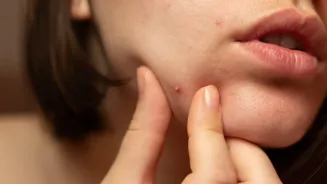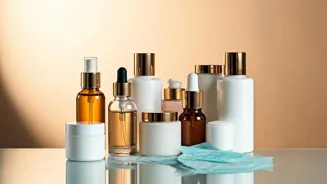Diet's Misconception
A prevalent belief links what you eat directly to acne. However, a dermatologist clarified that food is not the primary cause of acne, contrary to popular
belief. Though diet can influence overall health, it doesn't directly trigger breakouts in most cases. There's little definitive scientific backing to support the widespread idea that specific foods like chocolate or greasy items are the core cause of acne. The dermatologist explained that focusing solely on dietary changes to manage acne is often unproductive, as other factors hold greater weight. Understanding this perspective can assist in managing expectations when attempting acne treatment.
Hormonal Rollercoaster
Hormonal fluctuations are a significant factor in acne development, especially in adults. Changes in hormone levels, such as during menstruation, pregnancy, or menopause, can stimulate the sebaceous glands to produce more oil. This excess oil can clog pores and lead to acne. The dermatologist highlights that hormonal imbalances, often a hidden element, tend to be the prime cause of breakouts. This understanding helps explain why adult acne is so persistent. Addressing these hormonal shifts often requires targeted treatments, which may be more effective than diet-based approaches.
The Overproduction of Oil
An excess of sebum, or skin oil, is a core driver of acne. The dermatologist said that the overproduction of oil is a major factor. This excess oil can mix with dead skin cells, creating a blockage within pores. This obstruction then provides a breeding ground for bacteria, which exacerbates inflammation and leads to acne lesions. Various factors influence oil production, including genetics and environmental factors, but it is a central component of the acne process. Understanding the role of sebum is vital for selecting effective skincare treatments, such as products that help manage oil production.
Pore Blockage Unveiled
Pore blockages are another key factor leading to acne, according to the dermatologist. Dead skin cells, alongside excess oil, can become trapped within the pores, thereby forming a plug. This plug further obstructs the pore and prevents oil from escaping onto the skin’s surface. This is where bacteria begin to thrive, increasing the potential for acne. Strategies for managing acne often focus on exfoliation and cleansing to prevent and eliminate these pore blockages. Avoiding products that could clog pores is another key action that will also help in preventing and mitigating acne.
Bacteria's Role Examined
Bacteria, specifically *Cutibacterium acnes* (formerly *Propionibacterium acnes*), plays a significant part in acne development. The dermatologist explained that this bacteria thrives in clogged pores, where there's a lack of oxygen. As the bacteria multiply, they trigger an inflammatory response, leading to the development of pimples, cysts, and nodules. Targeting this bacteria with specific acne treatments, such as those containing benzoyl peroxide or antibiotics, is a common and effective strategy to combat breakouts. Reducing bacterial load and inflammation helps in improving the skin's condition.



